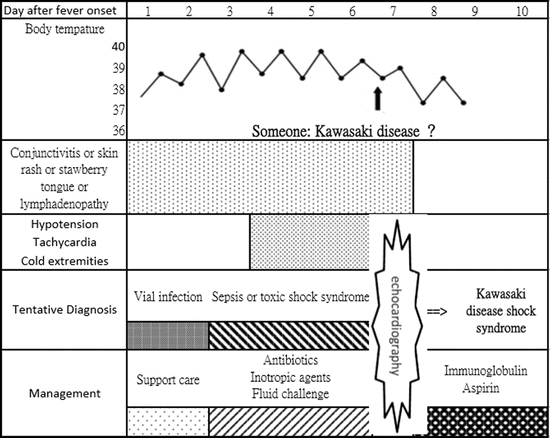
Kawasaki disease (KD) is an acute febrile systemic vasculitis of unknown etiology and often occurs in children under 5 years old. During the acute phase, approximately 5% of children with KD develop hypotension and shock, a severe condition termed KD shock syndrome (KDSS). Macrophage activation syndrome (MAS), another life-threatening complication, has been reported to be associated with KD, although rarely. KDSS complicated with MAS is extremely rare. In this article, we present our experience in the diagnosis and treatment of KDSS complicated with MAS. Patient concerns: A 5-month boy with fever for 5 days was diagnosed with KD. After 2 doses of intravenous immunoglobulin and regular antiinflammatory treatment at a local hospital, the fever did not subdue. He was admitted to our department on the 10th day of illness. The boy developed KDSS on the 11th day of illness. In the mean time, the boy had hepatosplenomegaly, and laboratory tests showed hypertriglyceridemia, hypofibrinogenemia, decreased blood red cells and platelets, increased ferritin and soluble sIL2Rα, and reduced natural killer cell activity. Diagnosis: The patient had KDSS complicated with MAS. Interventions: Emergency antishock therapy along with high-dose steroid with a longer tapering course was carried out. Following these treatments, fever subsided and other symptoms and signs relieved, but progressive coronary dilatation occurred, warfarin was thereby administered. Outcomes: The patient was discharged 30 days after hospitalization. Echocardiography at the 2 month follow-up showed regression of coronary aneurysm. Lessons: Laboratory testing is critical for the diagnosis of MAS and we recommend that 2009 HLH diagnostic criteria be used for the diagnosis of MAS in KD. Emergency treatment of shock and a longer course of high-dose steroid anti-inflammatory therapy are vital for the management of KDSS complicated with MAS.
No comments:
Post a Comment